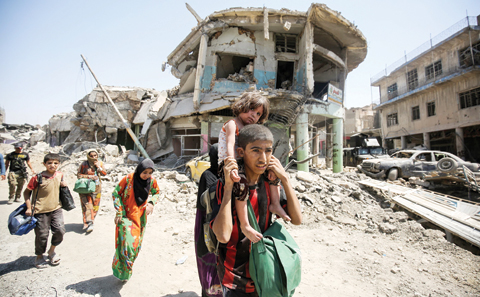Districts still devastated months after IS was forced out - ‘90%’ of the bridges totally or partially destroyed
 MOSUL: An Iraqi boy carries a girl on his back while fleeing from the Old City of Mosul during the Iraqi government forces’ offensive to retake the city from Islamic State (IS) group fighters. — AFP
MOSUL: An Iraqi boy carries a girl on his back while fleeing from the Old City of Mosul during the Iraqi government forces’ offensive to retake the city from Islamic State (IS) group fighters. — AFPMOSUL: It used to take Ahmad Meyssar just a few minutes to reach his university across a bridge over the river Tigris in Iraq's Mosul. But now-with whole districts still devastated some five months after the Islamic State group was forced out-the journey takes him over two hours as most of the vital links between the two halves of the city remain in ruins. "To be sure of being on time for the start of lessons at university at eight in the morning," the 20-year-old student says he sets off "at around 5:30 or six".
Across the Nineveh region where Iraq's second-largest city is located, some "90 percent" of the 70 bridges have been totally or partially destroyed, said Marwan Abderrazaq from the local roads department. Some of Mosul's bridges were blown up by IS jihadists as they faced a nine-month Iraqi onslaught, while others were destroyed by government forces and the firepower of a US-led coalition backing them up. They have been reduced to pillars jutting out of the waters of the Tigris or collapsed into piles of concrete.
Traffic problems
For millions of residents in Mosul and the broader region the disappearance of the bridges they used to rely on has turned daily life into an arduous obstacle course. Thanks to support from the World Bank and United Nations two temporary bridges have gone up in Mosul and three more are under construction. That means locals no longer have to make lengthy detours to the few towns where the river could be traversed. But the limited options still mean that student Meyssar and others wanting to cross still face major delays.
Hundreds of cars lined up as they queued to reach the other side on a recent morning, forming a traffic jam that stretched for several kilometers. The frustrating waits occur daily at the two functioning bridges-even for pedestrians. Fathiya Subhi, 44, carries one of her children on her shoulders as she looks to reach the other side of the river. She is making the crossing by foot as she "cannot afford the taxi fare" across. With the bridge choked full with cars and scooters it takes her over 30 minutes just to dodge and weave her way across the 330-metre (1,000-foot) bridge. "We cannot live like this!" she exclaims. "When the government returned didn't it also have to rebuild everything for the people living here?"
Changing habits
The jams and delays crossing the river have forced taxi driver Yahya Ahmed to change the way he works. He has decided that from now on he is going to stick to the eastern side of the river where he lives and will no longer take passengers to the other bank. "Before we used to cross from one side to the other without thinking about it," Ahmed, 37, says. "But now it takes two-and-a-half hours so I just work on one side." Engineer Hussein Nabil is at work helping to try and rebuild what residents called the "Old Bridge" that ran across the centre of Mosul since it was built in 1934. But he says the metallic structure will only be "restored in six months" and it will take until August-over a year after Baghdad announced Mosul's "liberation"-for the first cars to be able to cross.- AFP









